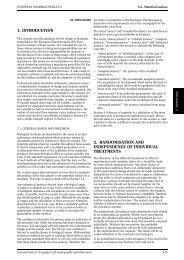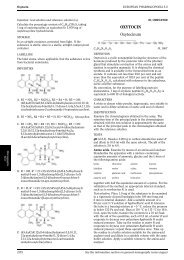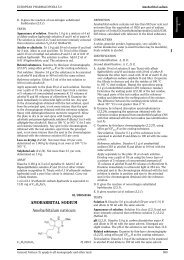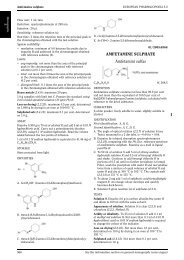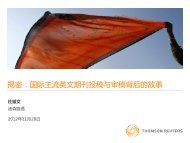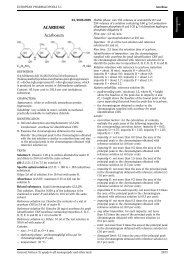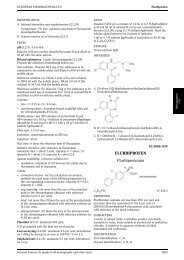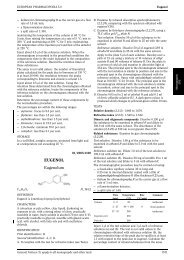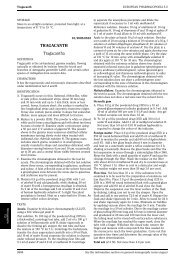EXTRACTS Extracta
EXTRACTS Extracta
EXTRACTS Extracta
Create successful ePaper yourself
Turn your PDF publications into a flip-book with our unique Google optimized e-Paper software.
EUROPEAN PHARMACOPOEIA 5.0 Extracts<br />
the section on Purified water in bulk of the monograph on<br />
Purified water (0008) is suitable. Potable water may be<br />
suitable if it complies with a defined specification that allows<br />
the consistent production of a suitable extract.<br />
Where applicable, concentration to the intended consistency<br />
is carried out using suitable methods, usually under reduced<br />
pressure, and at a temperature at which deterioration of the<br />
constituents is reduced to a minimum. Essential oils that<br />
have been separated during processing may be restored to<br />
the extracts at an appropriate stage in the manufacturing<br />
process. Suitable excipients may be added at the various<br />
stages of the manufacturing process for example to improve<br />
technological qualities such as homogeneity or consistency.<br />
Suitable stabilisers and antimicrobial preservatives may also<br />
be added.<br />
Extraction with a given solvent leads to typical proportions<br />
of characterised constituents in the extractable matter;<br />
during production of standardised and quantified extracts,<br />
purification procedures may be applied that increase these<br />
proportions with respect to the expected values; such<br />
extracts are referred to as “refined”.<br />
IDENTIFICATION<br />
Extracts are identified using a suitable method.<br />
TESTS<br />
Where applicable, as a result of analysis of the herbal drug<br />
or animal matter used for production and in view of the<br />
production process, tests for microbiological quality (5.1.4),<br />
heavy metals, aflatoxins, pesticide residues (2.8.13) inthe<br />
extracts may be necessary.<br />
ASSAY<br />
Wherever possible, extracts are assayed by a suitable method.<br />
LABELLING<br />
The label states:<br />
— the herbal drug or animal matter used,<br />
— whether the extract is liquid, soft or dry, or whether it<br />
is a tincture,<br />
— for standardised extracts, the content of constituents with<br />
known therapeutic activity,<br />
— for quantified extracts, the content of constituents<br />
(markers) used for quantification,<br />
— the ratio of the starting material to the genuine extract<br />
(DER),<br />
— the solvent or solvents used for extraction,<br />
— where applicable, that a fresh herbal drug or fresh animal<br />
matter has been used,<br />
— where applicable, that the extract is “refined”,<br />
— the name and amount of any excipient used including<br />
stabilisers and antimicrobial preservatives,<br />
— where applicable, the percentage of dry residue.<br />
Liquid extracts — extracta fluida<br />
DEFINITION<br />
Liquid extracts are liquid preparations of which, in general,<br />
1 part by mass or volume is equivalent to 1 part by mass of the<br />
dried herbal drug or animal matter. These preparations are<br />
adjusted, if necessary, so that they satisfy the requirements<br />
for content of solvent, and, where applicable, for constituents.<br />
PRODUCTION<br />
Liquid extracts are prepared by using ethanol of suitable<br />
concentration or water to extract the herbal drug or animal<br />
matter, or by dissolving a soft or dry extract (which has been<br />
produced using the same strength of extraction solvent as<br />
is used in preparing the liquid extract by direct extraction)<br />
of the herbal drug or animal matter in either ethanol of<br />
suitable concentration or water. Liquid extracts may be<br />
filtered, if necessary.<br />
Aslightsedimentmayformonstanding,whichisacceptable<br />
as long as the composition of the liquid extract is not<br />
changed significantly.<br />
TESTS<br />
Relative density (2.2.5). Where applicable, the liquid extract<br />
complies with the limits prescribed in the monograph.<br />
Ethanol (2.9.10). For alcoholic liquid extracts, carry out<br />
the determination of ethanol content. The ethanol content<br />
complies with that prescribed.<br />
Methanol and 2-propanol (2.9.11): maximum 0.05 per<br />
cent V/V of methanol and maximum 0.05 per cent V/V of<br />
2-propanol for alcoholic liquid extracts unless otherwise<br />
prescribed.<br />
Dry residue (2.8.16). Where applicable, the liquid extract<br />
complies with the limits prescribed in the monograph,<br />
corrected if necessary, taking into account any excipient<br />
used.<br />
STORAGE<br />
Protected from light.<br />
LABELLING<br />
The label states in addition to the requirements listed above:<br />
— where applicable, the ethanol content in per cent V/V in<br />
the final extract.<br />
Tinctures — tincturae<br />
DEFINITION<br />
Tinctures are liquid preparations which are usually obtained<br />
using either 1 part of herbal drug or animal matter and<br />
10 parts of extraction solvent or 1 part of herbal drug or<br />
animal matter and 5 parts of extraction solvent.<br />
PRODUCTION<br />
Tinctures are prepared by maceration or percolation (outline<br />
methodology is given below) using only ethanol of a suitable<br />
concentration for extraction of the herbal drug or animal<br />
matter, or by dissolving a soft or dry extract (which has been<br />
produced using the same strength of extraction solvent as<br />
is used in preparing the tincture by direct extraction) of<br />
the herbal drug or animal matter in ethanol of a suitable<br />
concentration. Tinctures are filtered, if necessary.<br />
Tinctures are usually clear. A slight sediment may form on<br />
standing which is acceptable as long as the composition of<br />
the tincture is not changed significantly.<br />
Production by maceration. Unless otherwise prescribed,<br />
reduce the herbal drug or animal matter to be extracted to<br />
pieces of suitable size, mix thoroughly with the prescribed<br />
extraction solvent and allow to stand in a closed container<br />
for an appropriate time. The residue is separated from the<br />
extraction solvent and, if necessary, pressed out. In the latter<br />
case, the 2 liquids obtained are combined.<br />
Production by percolation. If necessary, reduce the herbal<br />
drug or animal matter to be extracted to pieces of suitable<br />
size. Mix thoroughly with a portion of the prescribed<br />
extraction solvent and allow to stand for an appropriate time.<br />
Transfer to a percolator and allow the percolate to flow at<br />
room temperature slowly making sure that the herbal drug<br />
GeneralNotices(1)applytoallmonographsandothertexts 571



